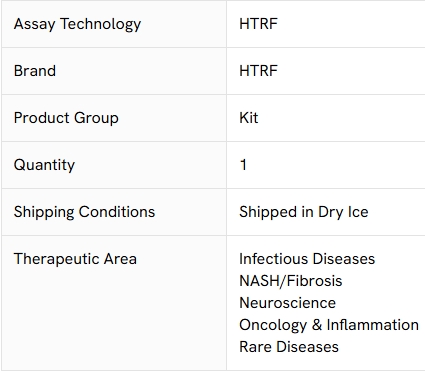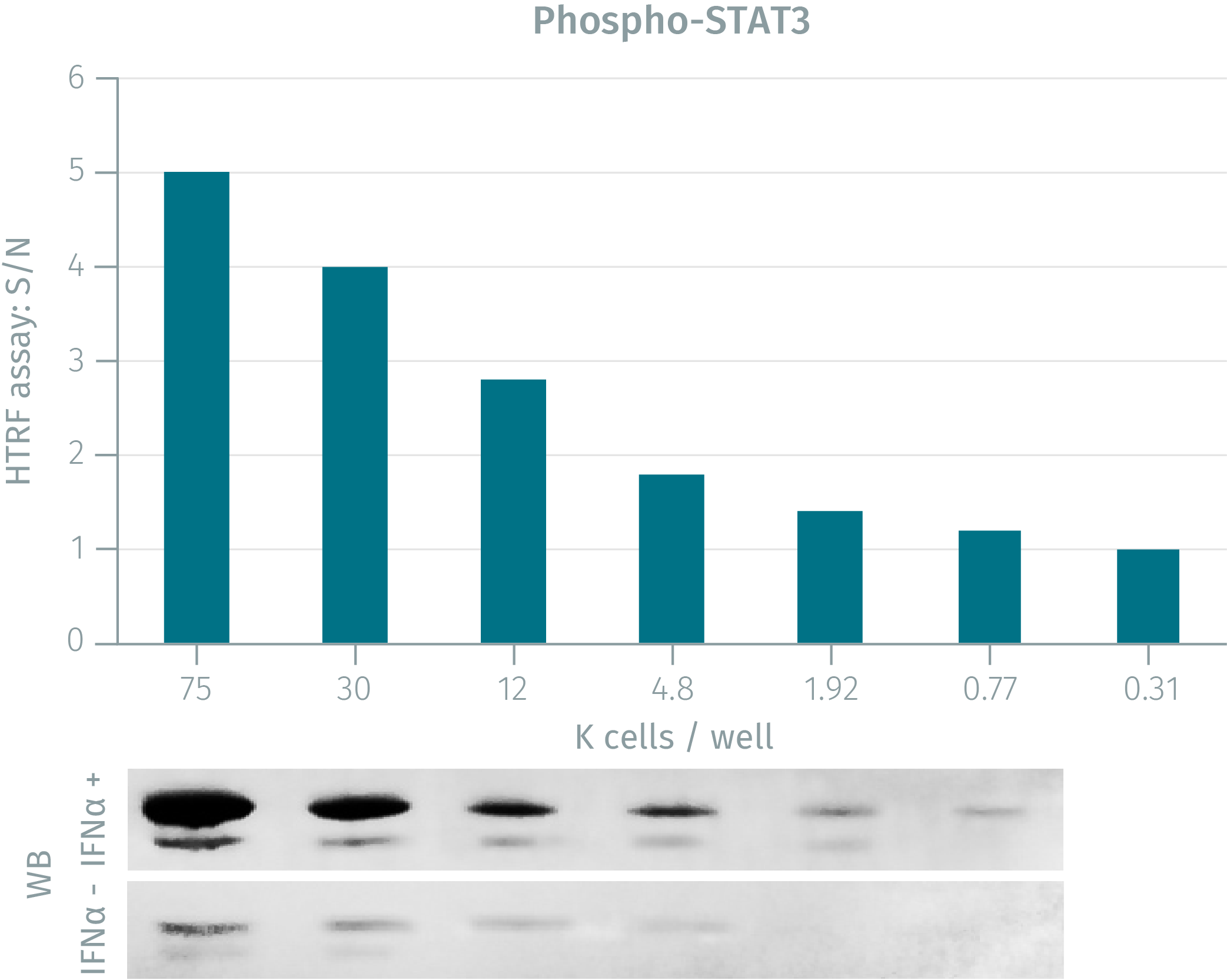| Cat.NO | Name | Size |
| 62AT3PEG | HTRF STAT3 P-Y705 KIT | 500 PTS |
| 62AT3PEH | HTRF STAT3 P-Y705 KIT | 10K PTS |
This HTRF cell-based assay enables rapid, quantitative detection of STAT3 phosphorylated on Tyr705 as a readout of JAK/STAT signaling activity. STAT3 is upregulatd in many cancers, making it a powerful tool in anti-cancer research.

How it works
Phospho-STAT3 (Tyr705) assay principle
The Phospho-STAT3 (Tyr705) assay measures STAT3 when phosphorylated at Tyr705. Contrary to Western Blot, the assay is entirely plate-based and does not require gels, electrophoresis or transfer. The Phospho-STAT3 (Tyr705) assay uses 2 labeled antibodies: one with a donor fluorophore, the other one with an acceptor. The first antibody is selected for its specific binding to the phosphorylated motif on the protein, the second for its ability to recognize the protein independent of its phosphorylation state. Protein phosphorylation enables an immune-complex formation involving both labeled antibodies and which brings the donor fluorophore into close proximity to the acceptor, thereby generating a FRET signal. Its intensity is directly proportional to the concentration of phosphorylated protein present in the sample, and provides a means of assessing the protein's phosphorylation state under a no-wash assay format.
Phospho-STAT3 (Tyr705) 2-plate assay protocol
The 2 plate protocol involves culturing cells in a 96-well plate before lysis then transferring lysates to a 384-well low volume detection plate before adding phospho-STAT3 (Tyr705) HTRF detection reagents. This protocol enables the cells' viability and confluence to be monitored.
Phospho-STAT3 (Tyr705) 1-plate assay protocol
Detection of Phosphorylated STAT3 (Tyr705) with HTRF reagents can be performed in a single plate used for culturing, stimulation and lysis. No washing steps are required. This HTS designed protocol enables miniaturization while maintaining robust HTRF quality.
Assay validation
HTRF compared to Western Blot using phospho-STAT3 assay
HeLa cells were grown for 2 days in a T175 flask 37°C, 5%Co2. Stimulation was done with 5nM of IFNa for 15min. Cell culture medium was eliminated and cells supplemented with 3ml of lysis buffer before incubating for 45min. Soluble supernatants were collected after 10min centrifuging. Equal amounts of lysates were used for a side by side comparison of WB and HTRF. The two methods show a comparable sensitivity level: 750 cells. HTRF offers superior convenience over western blot.

IL6 dose-response on NIH 3T3 cells
Murine NIH 3T3 cells (100,000 cells/well) were stimulated for 30 minutes at 37°C with various concentrations of IL6. After a 30-minute lysis incubation time, phosphorylated STAT3 was measured using the two-plate assay protocol of the HTRF phopsho-STAT3(Tyr705) cellular assay kit.
Inhibition effect of JAK inhibitor on HeLa cells
HeLa cells (100,000 cells/well) were incubated for 1 hour at 37°C with various concentrations of antagonist. Agonist (IFNα) was then added and incubated for 30 minutes. After a 30-minute lysis incubation time, phosphorylated STAT3 was measured using the two-plate assay protocol of the HTRF phopsho-STAT3(Tyr705) cellular assay kit.
HTRF total-STAT3 assay used to check the phosphorylation status of STAT3
Hela cells (100,000 cells/well) were activated with IFNa for 15 min, using the two-plate assay protocol of the Phospho-STAT3 (Tyr705) and Total-STAT3 assays. Results obtained show a dose-response increase of STAT3 phosphorylation upon IFNα stimulation, while STAT3 expression level remains constant.
In response to cytokines and growth factors, STAT3 is phosphorylated by receptor-associated kinases and then forms dimers that translocate to the cell nucleus, where they act as transcription activators. STAT3 mediates the expression of a variety of genes in response to cell stimuli, and thus plays a key role in many cellular processes such as cell growth and apoptosis. The binding of Interleukin 6 - family cytokines to the gp130 receptor triggers STAT3 phosphorylation by JAK2. STAT3 is also a target of other receptors such as RTKs (EGFR, cmet.) and c-src.
At Revvity, we regard "impossibility" as inspiration and "inability" as the driving force. Revvity offers health science solutions, cutting - edge technologies and professional services, with its business covering the entire end - to - end process of scientific research exploration, development, diagnosis, and treatment. Relying on years of in - depth cultivation in fields such as translational multi - omics technology, biomarker identification, imaging, disease prediction, screening, detection and diagnosis, and informatics, Revvity is using the power of technology to break through the boundaries of human potential.
In 2023, Revvity's turnover exceeded $2.7 billion. It has more than 11,000 employees worldwide and provides diverse services for customers such as pharmaceutical and biotechnology enterprises, diagnostic laboratories, scientific research institutions and government agencies. The company is a member of the S&P 500 Index, and its customers are spread across more than 190 countries and regions around the world.
Online Message